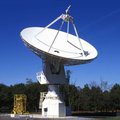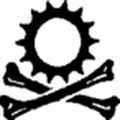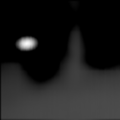video telescopes are going to kill the radio telescopes
 Great! Looking forward. I've also built my own free-to-use open source radio telescope for anyone wishing to observe the radio sky for free without building their own instruments: https://pictortelescope.com/ & https://github.com/0xCoto/PICTOR
Great! Looking forward. I've also built my own free-to-use open source radio telescope for anyone wishing to observe the radio sky for free without building their own instruments: https://pictortelescope.com/ & https://github.com/0xCoto/PICTOR
 neat
neat
 @0xCoto: That's three now that I've gotten to see. Yours, the one Dr. Aguirre built, and mine.
@0xCoto: That's three now that I've gotten to see. Yours, the one Dr. Aguirre built, and mine.
 Awesome, got a link to yours?
Awesome, got a link to yours?
 Blog posts: https://josepheoff.github.io/posts/rfcamera
Blog posts: https://josepheoff.github.io/posts/rfcamera
 Anybody have any open source plans for a 70m?
Anybody have any open source plans for a 70m?
 70m?
70m?
 Hardware: https://github.com/JosephEoff/Karl-PCB
Hardware: https://github.com/JosephEoff/Karl-PCB
 You know, like https://en.wikipedia.org/wiki/Yevpatoria_RT-70_radio_telescope
You know, like https://en.wikipedia.org/wiki/Yevpatoria_RT-70_radio_telescope
 Software: https://github.com/JosephEoff/Grote and https://github.com/JosephEoff/scanner
Software: https://github.com/JosephEoff/Grote and https://github.com/JosephEoff/scanner
 @Ethan Waldo Well I don't have a 70-meter antenna, so...
@Ethan Waldo Well I don't have a 70-meter antenna, so...
 I also wrote my own software for my radio telescope: https://github.com/0xCoto/VIRGO
I also wrote my own software for my radio telescope: https://github.com/0xCoto/VIRGO
 Very few folks have the space for a 70m dish. That's bigger than my house.
Very few folks have the space for a 70m dish. That's bigger than my house.
 My attempts at humor have failed....
My attempts at humor have failed....
 @0xCoto: In just the three examples I've seen, there's three different set of hardware. You are working with an SDR and doing frequency analysis. Dr. Aguirre used a commercial RF level detector, and I built my own level detector.
@0xCoto: In just the three examples I've seen, there's three different set of hardware. You are working with an SDR and doing frequency analysis. Dr. Aguirre used a commercial RF level detector, and I built my own level detector.
 Do you guys do any time coding?
Do you guys do any time coding?
 @Joseph Eoff No reason to stick to a radiometer when you can derive the same data and more with a spectrometer. :)
@Joseph Eoff No reason to stick to a radiometer when you can derive the same data and more with a spectrometer. :)
 Hey Marcus!
Hey Marcus!
 I just find the differences in the concepts between the three rigs fascinating.
I just find the differences in the concepts between the three rigs fascinating.
 Hey.
Hey.
 I just posted in the FB permaculture group about this chat. Anyone here from there?--73 de KK6VDR
I just posted in the FB permaculture group about this chat. Anyone here from there?--73 de KK6VDR
 We have several DIY radio telescopes. And a technical memo Series about some of them and the techniques we are using.
We have several DIY radio telescopes. And a technical memo Series about some of them and the techniques we are using.
 I wrote one of the first DIY radio telescope articles using RTLSDR several years ago now. On our website.
I wrote one of the first DIY radio telescope articles using RTLSDR several years ago now. On our website.
 Radio astronomy at the backyard level is unlike optical. You can’t go to a Walmart and buy a radio telescope.
Radio astronomy at the backyard level is unlike optical. You can’t go to a Walmart and buy a radio telescope.
![]() i hope this hack chat motivates me to get back into radio astronomy. last I experimented with was in August last year. Made a manual picture of the sun on a very overcast day. https://hvdnnotebook.blogspot.com/2019/08/presentation-radio-astronomy.html
i hope this hack chat motivates me to get back into radio astronomy. last I experimented with was in August last year. Made a manual picture of the sun on a very overcast day. https://hvdnnotebook.blogspot.com/2019/08/presentation-radio-astronomy.html
![]() Now that things like Direct TV dishes are in short supply what alternatives are you guys using?
Now that things like Direct TV dishes are in short supply what alternatives are you guys using?
 Hey! I also build a small scale radio telescope a couple of years ago, and its on my hackaday page if anyone wants to check it out. I also started building a larger one, able to observe the Hydrogen line, but it got expensive rlly fast haha :( .... I actually got some help from @0xCoto (thanks!)
Hey! I also build a small scale radio telescope a couple of years ago, and its on my hackaday page if anyone wants to check it out. I also started building a larger one, able to observe the Hydrogen line, but it got expensive rlly fast haha :( .... I actually got some help from @0xCoto (thanks!)
 You can still buy dishes online. 1.5m offset are routinely available on eBay.
You can still buy dishes online. 1.5m offset are routinely available on eBay.
 I wonder if anyone has ever combined a tracking telescope with solar energy collection and/or a dome-shaped greenhouse?
I wonder if anyone has ever combined a tracking telescope with solar energy collection and/or a dome-shaped greenhouse?
 At VHF you can build or buy Yagis
At VHF you can build or buy Yagis
 FTA stuff on ebay is 90cm and 1.2m. Kinda small though.
FTA stuff on ebay is 90cm and 1.2m. Kinda small though.
 Hopefully this hack chat motivates me to get back in radio astronomy
Hopefully this hack chat motivates me to get back in radio astronomy
 You can still buy larger dishes online, just not on eBay.
You can still buy larger dishes online, just not on eBay.
 Lots of Big Ugly Dishes sitting in people’s back yard having not been used since 1995.
Lots of Big Ugly Dishes sitting in people’s back yard having not been used since 1995.
 An advantage of an FFT approach is that you can apply a spectral mask prior to computing total power even if you’re not doing spectral work.
An advantage of an FFT approach is that you can apply a spectral mask prior to computing total power even if you’re not doing spectral work.
 Greetings, all! Welcome to the Hack Chat. Not sure if Dr. Aguirre is logged in yet - he said he had a meeting just before this, so he should be along soon. We'll kick off when he logs on. Until then, enjoy the pre-chat!
Greetings, all! Welcome to the Hack Chat. Not sure if Dr. Aguirre is logged in yet - he said he had a meeting just before this, so he should be along soon. We'll kick off when he logs on. Until then, enjoy the pre-chat!
 Ty. (FFT=Fast Fourier transform)
Ty. (FFT=Fast Fourier transform)
![]() I went on a binge on Facebook Marketplace and Craigslist looking for dish's for an "art project" this part summer. Ended up with an overwhelming response of dish donation options. Scored some nice Wildblue dishes which were popular in my area for satellite based internet back in the day. Moral = Free dishes are there for the asking!
I went on a binge on Facebook Marketplace and Craigslist looking for dish's for an "art project" this part summer. Ended up with an overwhelming response of dish donation options. Scored some nice Wildblue dishes which were popular in my area for satellite based internet back in the day. Moral = Free dishes are there for the asking!
 You can even offer to take old ones off of roofs, although that's tricky if you don't know what you're doing - could result in leaks.
You can even offer to take old ones off of roofs, although that's tricky if you don't know what you're doing - could result in leaks.
 yeah, I see DISH network ones on the side of the road *all the time*
yeah, I see DISH network ones on the side of the road *all the time*
 I would like to get a "Big Ugly Dish" and a big round trampoline frame free for the hauling somewhere.
I would like to get a "Big Ugly Dish" and a big round trampoline frame free for the hauling somewhere.
 ^ that too, easy, just take the dish and leave what ever it's attached too
^ that too, easy, just take the dish and leave what ever it's attached too
![]() @Dan Maloney or an injury not covered under insurance :)
@Dan Maloney or an injury not covered under insurance :)
 IIRC, the installer puts a "pitch pad" down under the bracket that seals the holes made by the mounting screws
IIRC, the installer puts a "pitch pad" down under the bracket that seals the holes made by the mounting screws
 Hello @James Aguirre ! Welcome to the Hack Chat!
Hello @James Aguirre ! Welcome to the Hack Chat!
![]() Hello!
Hello!
![]() I tried that once lol found it on Facebook Marketplace. Spent an hour with a random family trying to get the dish off and it never came off.
I tried that once lol found it on Facebook Marketplace. Spent an hour with a random family trying to get the dish off and it never came off.
 We can get started now, although we've been having a great chat on sourcing Dish network antennas.
We can get started now, although we've been having a great chat on sourcing Dish network antennas.
![]() Great! Dish network or DirectTV is what I've been using
Great! Dish network or DirectTV is what I've been using
 Can you perhaps kick us off by telling us a little about your background and how you got interested in homebrew radio astronomy?
Can you perhaps kick us off by telling us a little about your background and how you got interested in homebrew radio astronomy?
![]() Hi everybody!
Hi everybody!
 hi!
hi!
 hey!
hey!
 Hi!
Hi!
 Hi!
Hi!
![]() I'm potentially going to embarrass myself because this is - more or less - what I do professionally, but of course at a completely different scale.
I'm potentially going to embarrass myself because this is - more or less - what I do professionally, but of course at a completely different scale.
![]() Hi Dan - I'm a radio ham in Cape Town South Africa and I've been following the progress of the KAT project
Hi Dan - I'm a radio ham in Cape Town South Africa and I've been following the progress of the KAT project
 WOW
WOW
![]() My apologies - but just a novice who's keen to learn and spread the word
My apologies - but just a novice who's keen to learn and spread the word
![]() I'm with Allan but I'd love to be on the level you are James
I'm with Allan but I'd love to be on the level you are James
![]() I'm a professor at the University of Pennsylvania and have been building various kinds of telescopes at non-optical wavelengths for about 20 years, but I wanted to do something small scale that I could use to teach and show students how it all works
I'm a professor at the University of Pennsylvania and have been building various kinds of telescopes at non-optical wavelengths for about 20 years, but I wanted to do something small scale that I could use to teach and show students how it all works
 @James Aguirre - true, but that leads to interesting questions about the differences between the "big stuff" and what you can accomplish at home
@James Aguirre - true, but that leads to interesting questions about the differences between the "big stuff" and what you can accomplish at home
![]() @Dan Maloney these days, the gap is narrowing! :)
@Dan Maloney these days, the gap is narrowing! :)
![]() is the _the_ Karl Jansky @kjansky1?
is the _the_ Karl Jansky @kjansky1?
![]() @Allan one of the projects I work on is quite close to KAT at the site in the Karoo
@Allan one of the projects I work on is quite close to KAT at the site in the Karoo
 His alter ego unfortunately!
His alter ego unfortunately!
![]() Well I hope you can stand the heat
Well I hope you can stand the heat
![]() It's called HERA http://reionization.org/
It's called HERA http://reionization.org/
![]() I've not been there in some years - I'm due for a trip back
I've not been there in some years - I'm due for a trip back
 Oh awesome project.
Oh awesome project.
![]() Thanks James - I'll take a look
Thanks James - I'll take a look
![]() Curious if you'll get to this, but what are your thoughts on the potential impact of large numbers of "small scale backyard units" that are knit together into a cooperative network.... kind of like what SATNOGS did (build a backbone network of lots of "small scale" observers)
Curious if you'll get to this, but what are your thoughts on the potential impact of large numbers of "small scale backyard units" that are knit together into a cooperative network.... kind of like what SATNOGS did (build a backbone network of lots of "small scale" observers)
![]() A lot of the work has been software: we generate something like 2 TB of data a night, and we're not at full scale yet
A lot of the work has been software: we generate something like 2 TB of data a night, and we're not at full scale yet
![]() @Frank googling SATNOGS now ...
@Frank googling SATNOGS now ...

https://en.wikipedia.org/wiki/KAT-7--Awesome!
![]() @Frank that would be awesome,
@Frank that would be awesome,
![]() "I'm due for a trip back" - excellent - look forward to seeing you
"I'm due for a trip back" - excellent - look forward to seeing you
![]() oh, basically they democratized ground stations for VHF and UHF (and some S-band) for anyone flying "amateur" science payloads on cubesats, etc...
oh, basically they democratized ground stations for VHF and UHF (and some S-band) for anyone flying "amateur" science payloads on cubesats, etc...

https://hackaday.com/2015/02/19/ground-stations-are-just-the-beginning-the-satnogs-story/
Ground Stations Are Just The Beginning: The SatNOGS Story
When you think of satellites, you may think of the Space Shuttle extending its robot arm with a huge piece of high-tech equipment waiting to pirouette into orbit. This misconception is similar to picturing huge mainframes when thinking about computers. The future (and arguably even the present) reality of satellites is smaller, cheaper, and more prolific.
 yes, but basically telemetry instead of signal combining
yes, but basically telemetry instead of signal combining
 At what redshift frequency would you think that the reionization band will occur?
At what redshift frequency would you think that the reionization band will occur?
 @Frank The problem is combining the signals requires top-notch equipment since timing information (for proper phase correlation) is crucial.
@Frank The problem is combining the signals requires top-notch equipment since timing information (for proper phase correlation) is crucial.
![]() the biggest benefit is that hey have a coordinated network to bring the vast numbers (~400+) of observers into some form of cohesive value.
the biggest benefit is that hey have a coordinated network to bring the vast numbers (~400+) of observers into some form of cohesive value.
![]() Can I put a question on the table?
Can I put a question on the table?
![]() What sort of hardware are you looking at to network and harvest the data?
What sort of hardware are you looking at to network and harvest the data?
![]() @0xCoto yup... but there too there can be effort to sync with GPS (and other) 1ppm accuracy... or is that not sufficient ?
@0xCoto yup... but there too there can be effort to sync with GPS (and other) 1ppm accuracy... or is that not sufficient ?
![]() right - so if you just want to monitor satellites, then each antenna can be "independent" and it's just a question of putting all that data in one place to be useful. @0xCoto is right that actually combining the signals as an interferometer (like HERA or EHT) is a whole other kettle of fish ...
right - so if you just want to monitor satellites, then each antenna can be "independent" and it's just a question of putting all that data in one place to be useful. @0xCoto is right that actually combining the signals as an interferometer (like HERA or EHT) is a whole other kettle of fish ...
 Timing accuracy depends on the frequency of operation.
Timing accuracy depends on the frequency of operation.
 @allan - Take a look at this for a primer:
@allan - Take a look at this for a primer:

https://hackaday.com/2019/10/22/a-miniature-radio-telescope-in-every-backyard/
A Miniature Radio Telescope In Every Backyard
You probably wouldn't expect to see somebody making astronomical observations during a cloudy day in the center of a dense urban area, but that's exactly what was happening at the recent 2019 Philadelphia Mini Maker Faire.
![]() @kjansky1 the rest frequency of the hydrogen emission is 1420 MHz, and it gets stretched by a factor of about 10 in coming to us, so we're looking at around 150 MHz
@kjansky1 the rest frequency of the hydrogen emission is 1420 MHz, and it gets stretched by a factor of about 10 in coming to us, so we're looking at around 150 MHz
 If anyone's interested, I've written a guide on building your own radio telescope from scratch: https://pictortelescope.com/Building_your_very_first_Radio_Telescope.pdf
If anyone's interested, I've written a guide on building your own radio telescope from scratch: https://pictortelescope.com/Building_your_very_first_Radio_Telescope.pdf
![]() cool - thanks Dan
cool - thanks Dan
 And rest assured that I'll be posting a transcript after the chat in case you need to refer back for links and such
And rest assured that I'll be posting a transcript after the chat in case you need to refer back for links and such
![]() I'll just add that I've got (some) more practically useful info and software at https://github.com/UPennEoR/MiniRadioTelescope
I'll just add that I've got (some) more practically useful info and software at https://github.com/UPennEoR/MiniRadioTelescope
![]() throwing out the "Deeper and Deeper down to wonderland"... White Rabbit ? https://ohwr.org/projects/white-rabbit sync at sub nano done at looong baselines.
throwing out the "Deeper and Deeper down to wonderland"... White Rabbit ? https://ohwr.org/projects/white-rabbit sync at sub nano done at looong baselines.
![]() There's a definitely a lot missing but the goal is to eventually have enough info there that anyone could copy what we've done
There's a definitely a lot missing but the goal is to eventually have enough info there that anyone could copy what we've done
 Do DIY Radio Telescope people cross over into SETI/CETI activities much?
Do DIY Radio Telescope people cross over into SETI/CETI activities much?
 Http://www.ccera.ca has a lot of info as well.
Http://www.ccera.ca has a lot of info as well.
![]()
 Lutetium
Lutetium

Discussions
Become a Hackaday.io Member
Create an account to leave a comment. Already have an account? Log In.